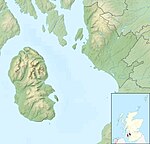
James III was King of Scots from 1460 until his death at the Battle of Sauchieburn in 1488. He inherited the throne as a child following the death of his father, King James II, at the siege of Roxburgh Castle. James III's reign began with a minority that lasted almost a decade, during which Scotland was governed by a series of regents and factions who struggled for possession of the young king before his personal rule began in 1469.
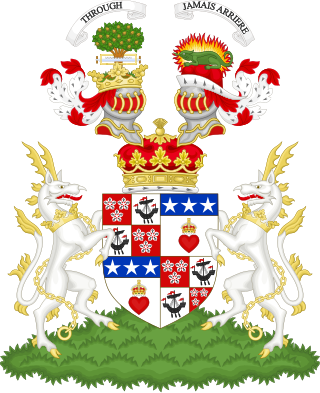
Duke of Hamilton is a title in the Peerage of Scotland, created in April 1643. It is the senior dukedom in that peerage, and as such its holder is the premier peer of Scotland, as well as being head of both the House of Hamilton and the House of Douglas. The title, the town of Hamilton in Lanarkshire, and many places around the world are named after members of the Hamilton family. The ducal family's surname, originally "Hamilton", is now "Douglas-Hamilton". Since 1711, the dukedom has been held together with the Dukedom of Brandon in the Peerage of Great Britain, and the dukes since that time have been styled Duke of Hamilton and Brandon, along with several other subsidiary titles.

Archibald Campbell, Marquess of Argyll, 8th Earl of Argyll, Chief of Clan Campbell was a Scottish nobleman, politician, and peer. The de facto head of Scotland's government during most of the conflict of the 1640s and 1650s known as the Wars of the Three Kingdoms, he was the main leader of the Covenanter movement that fought for the Establishment of Presbyterianism in opposition to the preference of King Charles I and the Caroline Divines for instead Establishing both High Church Anglicanism and Bishops. He is often remembered as the principal antagonist to the Royalist general James Graham, 1st Marquess of Montrose.

Kintyre is a peninsula in western Scotland, in the southwest of Argyll and Bute. The peninsula stretches about 30 miles, from the Mull of Kintyre in the south to East and West Loch Tarbert in the north. The region immediately north of Kintyre is known as Knapdale.

James Hamilton, 1st Duke of Châtellerault, 2nd Earl of Arran, was a Scottish nobleman and head of the House of Hamilton. A great-grandson of King James II of Scotland, he was heir presumptive to the Scottish throne. Arran was Regent of Scotland during the minority of Mary, Queen of Scots from 1543 to 1554, when he lost the regency to Mary of Guise. At first pro-English and Protestant, he converted to Catholicism in 1543 and supported a pro-French policy. He reluctantly agreed to Mary's marriage to Francis, eldest son of King Henry II of France, and was rewarded by Henry by being made Duke of Châtellerault in 1549. During the Scottish Reformation, Châtellerault joined the Protestant Lords of the Congregation to oppose the regency of Mary of Guise, and lost his French dukedom as a result.

James Hamilton, 3rd Earl of Arran (1537–1609) was a Scottish nobleman and soldier who opposed the French-dominated regency during the Scottish Reformation. He was the eldest son of James Hamilton, Duke of Châtellerault, sometime regent of Scotland. He was of royal descent, and at times was third or fourth in succession to the Scottish crown; several royal marriages were proposed for him, but he eventually never married. He went to France with Mary, Queen of Scots, where he commanded the Scots Guards. After returning to Scotland, he became a leader of the Protestant party against Mary and her French supporters. However, he went insane in 1562 and was confined for the rest of his life.

Anne Hamilton, 3rd Duchess of Hamilton was a Scottish peeress.

Claud Hamilton, 1st Lord Paisley was a Scottish nobleman who fought at the Battle of Langside in 1568 for Mary, Queen of Scots. He is the ancestor of the earls, marquesses and dukes of Abercorn.

Clan Douglas is an ancient clan or noble house from the Scottish Lowlands.
John Hamilton, 1st Marquess of Hamilton (1540–1604) was the founder of the long line of the marquesses and dukes of Hamilton in Scotland.

The Clan Hamilton, or House of Hamilton, is a Scottish clan of the Scottish Lowlands.
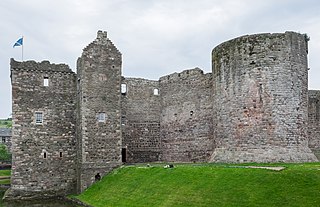
Rothesay Castle is a ruined castle in Rothesay, the principal town on the Isle of Bute, in western Scotland. Located at NS086646, the castle has been described as "one of the most remarkable in Scotland", for its long history dating back to the beginning of the 13th century, and its unusual circular plan.
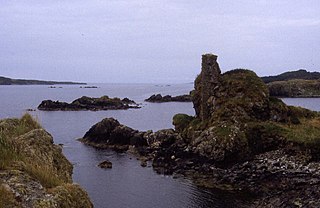
Dunyvaig Castle, is located on the south side of Islay, in Argyll, Scotland, on the shore of Lagavulin Bay, 4 kilometres from Port Ellen. The castle was once a naval base of the Lord of the Isles, chiefs of Clan Donald. It was held by the chiefs of the Clan MacDonald of Dunnyveg.

Clan Stuart of Bute is a Highland Scottish Clan and is a branch of the larger Clan Stewart.
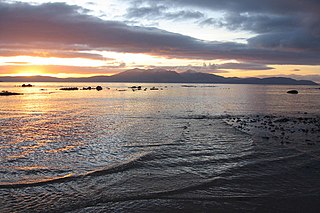
The Isle of Arran or simply Arran is an island off the west coast of Scotland. It is the largest island in the Firth of Clyde and the seventh-largest Scottish island, at 432 square kilometres (167 sq mi). Historically part of Buteshire, it is in the unitary council area of North Ayrshire. In the 2011 census it had a resident population of 4,629. Though culturally and physically similar to the Hebrides, it is separated from them by the Kintyre peninsula. Often referred to as "Scotland in Miniature", the Island is divided into highland and lowland areas by the Highland Boundary Fault and has been described as a "geologist's paradise".
Anne Hamilton, Countess of Huntly, was a Scottish noblewoman and a member of the powerful Hamilton family which had a strong claim to the Scottish crown. Her father James Hamilton, Duke of Châtellerault, 2nd Earl of Arran was heir presumptive to the throne of Scotland after Mary, Queen of Scots prior to the birth of the latter's son Prince James in 1566. Anne was the wife of George Gordon, 5th Earl of Huntly, Lord Chancellor of Scotland and a chief conspirator during the reign of Queen Mary.
Mary Stewart, Countess of Arran was the elder daughter of King James II of Scotland and Mary of Guelders. King James III of Scotland was her eldest brother. She married twice: firstly, to Thomas Boyd, 1st Earl of Arran; secondly, to James Hamilton, 1st Lord Hamilton. It was through her children by her second husband that the Hamilton earls of Arran and the Stewart earls of Lennox derived their claim to the Kingdom of Scotland.

Kinneil House is a historic house to the west of Bo'ness in east-central Scotland. It was once the principal seat of the Hamilton family in the east of Scotland. The house was saved from demolition in 1936 when 16th-century mural paintings were discovered, and it is now in the care of Historic Environment Scotland. The house now consists of a symmetrical mansion built in 1677 on the remains of an earlier 16th- or 15th-century tower house, with two rows of gunloops for early cannon still visible. A smaller east wing, of the mid 16th century, contains the two painted rooms. The house is protected as a Category A listed building.
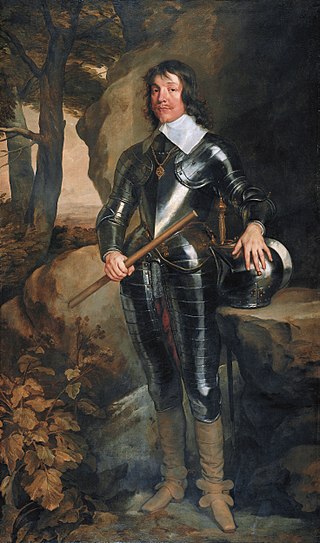
James Hamilton, 1st Duke of Hamilton, KG, PC, known as the 3rd Marquess of Hamilton from March 1625 until April 1643, was a Scottish nobleman and influential political and military leader during the Thirty Years' War and the Wars of the Three Kingdoms.

The earldom of Arran currently exists in two forms within the Scottish nobility, in reference to the Isle of Arran. One is a peerage title in the Peerage of Scotland, held as a subsidiary title by the Duke of Hamilton.


